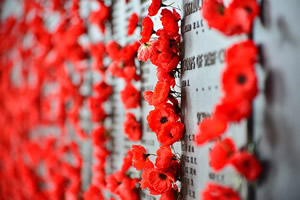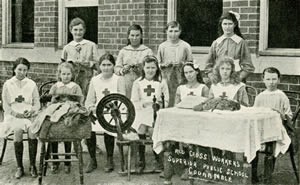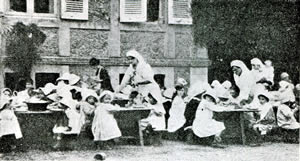History Stage 2
Overview

Poppies on the wall of remembrance, Australian War Memorial, Canberra, 2013
Students research war memorials and honour boards held in their local community and consider their significance. They research the role of the Red Cross during the First World War and the contribution of school children. Students explore how Anzac Day and Remembrance Day are commemorated in Australia and identify symbols of remembrance.
Teaching and learning activities

Red Cross Workers, Superior Public School, Coonamble, NSW (The Education Gazette, 1 January 1918)
©Department of Education (NSW Schoolhouse Museum of Public Education collection)
1. Change — How has our community changed? What features have been lost and what features have been retained?
Locate your local war memorials and honour boards on the war memorial register.
Review the images and information available. Identify the locations and if possible visit the sites.
Use a series of questions to develop students’ understanding of the specific features and characteristics of the memorial or honour board.
Are you aware of any other memorials or honour boards that are not registered? As a class collect the information to submit to the war memorial register.
Are memorials and honour boards important features of communities? Why or why not?
2. Caring — What is the nature of the contribution made by different groups and individuals in the community?
The Red Cross had a very significant role in the First World War. Research information about the role of the International Red Cross, based in Switzerland, the records they kept on prisoners of war and their role in assisting in returning prisoners home. Explore the concept of the ‘neutral’ role of the Red Cross.
Source: The International Committee of the Red Cross in the First World War. Also, in this resource, Red Cross (Experiences > Patriotic support tab).
Examine the specific role of the Australian Red Cross. Ensure students understand what a timeline is and how the information is organised chronologically.
Source: Red Cross—Timeline
Share and discuss some of the Red Cross stories and images from this time. Support students to prepare a short presentation on the role of Vera Deakin in the First World War or the work of the Australian Red Cross today.
Source: Red Cross—1914–1919
School children contributed to the war effort by raising funds as well as making and sending comfort items to soldiers. Research specific ways school children contributed to the war effort. Write a message of support to a soldier that can be tucked into a hand-knitted sock.
Sources: Patriotic Fundraising; NSW Schools and the Anzacs
3. Community — How has our community changed? What features have been lost and what features have been retained?
Find We Remember on Scootle. Review the presentation We Remember with students to examine some specific Australian symbols.
Undertake some research to find out the flag that was used during the First World War (mostly the Red Ensign).
Select and adapt teaching and learning ideas from We Remember, such as ‘How do we commemorate events and lives in Australia?’ Activities 1–3. Also ‘How and why have Australian symbols and events changed over the years?’ Activities 3–5. Support students to develop a research e-journal for selected activities.
Source: We Remember
4. Commemoration — How and why do people choose to remember significant events of the past?
Why do we commemorate Anzac Day? What happens on Anzac Day? What is the importance of Remembrance Day?
How are these two important commemorations the same and different?
What does Anzac Day mean today? What does Remembrance Day mean today?
Student work in groups to record what they know about both Anzac Day and Remembrance Day.
Students research the Anzac Day or Remembrance Day traditions and develop a personal or class commemoration ceremony.
Sources:
Remembrance Day (www.army.gov.au)
What is the significance of the Centenary of Anzac? Why is the 100 year commemoration of significance to Australians today? Why do we need to continue to remember?
Use a variety of sources to support students to develop an understanding of the development of national identities related to being Australian.
Use sources to explore how this commemoration can bring diverse communities together over time and place.
Learning concepts

French orphans eating food sent from New South Wales; French-Australian League. (The School Magazine, Part 2, 1 May 1917)
©Department of Education (NSW Schoolhouse Museum of Public Education collection)
These additional questions can be used for discussion or further investigations.
Change
Are memorials and honour boards important features of communities? Has their significance in communities changed?
Caring
How did the Red Cross care for those who served and families at home?
Community
What symbols are used for remembrance?
Commemoration
What does Anzac Day mean today?
What does Remembrance Day mean today?
What is the significance of the Centenary of Anzac to local communities?
Syllabus links
HT2-1 identifies celebrations and commemorations of significance in Australia and the world
HT2-2 describes and explains how significant individuals, groups and events contributed to changes in the local community over time
HT2-5 applies skills of historical inquiry and communication
The role that people of diverse backgrounds have played in the development and character of the local community (ACHHK062)
Students:
-
focusing on ONE group, investigate their diverse backgrounds and outline their contribution to the local community using a range of sources, eg photographs, newspapers, oral histories, diaries and letters
Days and weeks celebrated or commemorated in Australia (including Australia Day, ANZAC Day, Harmony Week, National Reconciliation Week, NAIDOC Week, National Sorry Day) and the importance of symbols and emblems (ACHHK063)
Students:
-
identify important Australian celebrations and commemorations and discuss their origins and significance in society